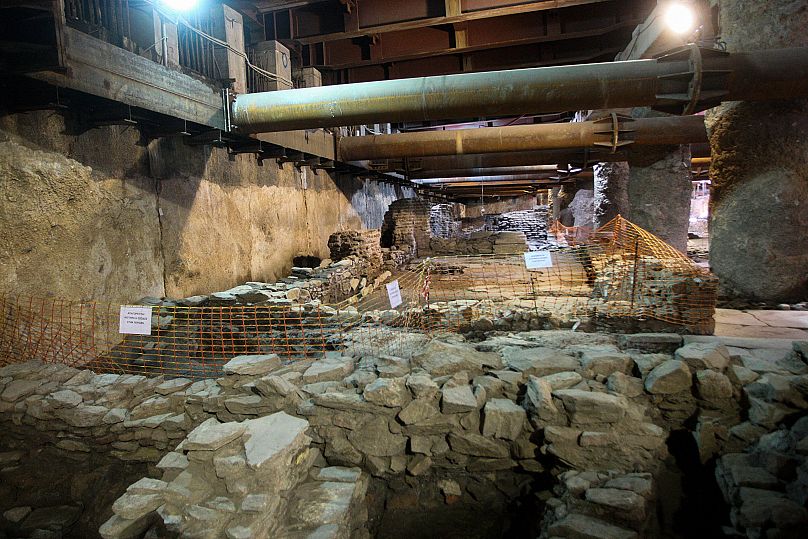I'm sharing this opinion piece by Alexis Georgoulis for you to make up your own mind. In Greece, an archaeological site of incalculable value is today at great risk of being irretrievably damaged. In 2013, the construction of the Venizelos metro station in Thessaloniki led to the discovery of impressive remains dating back to the Late Roman and Early Byzantine period (4th-9th century AD), a time when Thessaloniki was considered a multicultural city at the crossroads of East and West.
These archaeological findings are of immense historical and cultural importance because nowhere in the world has archaeology found a city’s central urban area belonging to this period which is so well preserved and boasts such a sprawling surface (the site covers over 1,500 m²).
The monumental ensemble includes parts of the Roman marble paved avenue Decumanus Maximus, its intersection with the main road of the city (the cardo maximus), workshops, shops and residencies, and portions of a square surrounded by colonnades. Some experts are even referring to the complex as the "Byzantine Pompeii" because it is found in excellent condition, and, as in the case of Pompeii, it gives a clear idea of how everyday life looked like back then.
But the way the Greek government has decided to handle the spectacular discovery has sparked a fierce debate, both at national and international level, and deserves the attention – and perhaps the intervention – of the European institutions.
In March 2020, despite the significance of this monumental complex and against the majority opinion of the archaeological community, the government decided to dismantle the ancient findings into bits and pieces and temporarily move them to a storage unit outside the city, with the intention of placing them back after the station’s construction. The main argument behind this decision was the need to finish the station’s construction in time and avoid any repercussions by the European Investment Bank, which finances the works of Thessaloniki’s metro.
In doing so, the government ignored a scientifically and technically solid solution for a win-win construction plan to build the station in time while keeping the antiquities in situ. This alternative scenario, which is both realistic and respectful, was proposed by a group of experts: to excavate and build the station under the archaeological layers.
According to archaeologists, the procedure of removing the findings destroys underlying archaeological strata and exposes them to external risks.
Moreover, the project of moving the delicate pieces is remarkably time-consuming: in case of removal, a new archaeological excavation must take place because under the level of the current complex lie another three meters of archaeological layers, estimated to be 700 years old.
The Greek government should learn the lessons from previous unsuccessful attempts. A similar plan was implemented when extremely important findings were discovered near the square of Hagia Sophia, also in Thessaloniki. The archaeological site was dismantled and stored outside the city. Unfortunately, after construction work was concluded, the effort to put the findings back in their original place proved to be impossible because they could no longer fit in the space from which they had been extracted.
We must make sure the remains found in the Venizelos station do not suffer the same fate.
Public opinion is overwhelming opposed to the removal: according to a recent survey, two out of three residents in Northern Greece don't support the extraction .
Neither does international law approve the strategy: all the international conventions on cultural heritage – namely the Charter for the Protection and Management of the Archaeological Heritage (Lausanne, 1990), UNESCO’s World Heritage Convention (revised on 10th of June 2019), the Nara Document on Authenticity (1994) and the Venice Charter (1964) – underline the need to preserve monuments of cultural importance in the location where they are originally discovered.
This is an essential precondition, regarding integrity and authenticity, for any monument to be considered for the World Heritage Monument list of UNESCO.
A possible awarding of the new archaeological site as a World Heritage Monument would be most beneficial for Thessaloniki, helping to promote the city as a tourist destination and bringing economic gains. It would be a pity to lose this potential title and all its advantages.
For all the above reasons, cultural institutions, such as Europa Nostra and the International Council on Monuments and Sites (ICOMOS), academics, civil society and legislators are being mobilised in order to stop the removal process and prevent a destructive scenario from happening.
Time is running out: Greece's highest administrative court, the Council of State, has already green-lighted the extraction, rejecting all three appeals by a thin margin of 13 out of 25 votes.
This problem concerns the whole Europe – and only Europe can act now.
My colleagues of the European Parliament and I have already addressed a question to the European Commission, asking if the executive intends to intervene and defend the preservation in situ of the Thessaloniki antiquities before the damage becomes irreparable. Going forward, the European Union must establish guidelines for similar cases to guarantee the substructure works doesn't entail the erosion of our ancient history.
We must seize this unique opportunity to build a modern metro line that benefits the city's development and connectivity while preserving and highlighting our common European cultural heritage.

Thank you for this kind of great information.
ReplyDeletePG Slotเว็บไหนดีPantip
Amazing post you have published here.
ReplyDeleteสมัครเว็บบอลออนไลน์
That's nice. It was a fine article.
ReplyDeleteยูฟ่า551